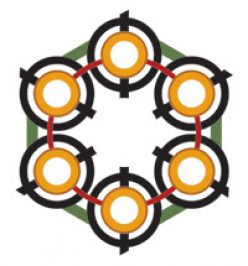by Flamingo Jones
The Erowid Crew had a good pace going in 2018 and 2019 with the archiving of Alexander and Ann Shulgin’s collection of documents, but efforts slowed to a near stop as the global pandemic took hold in early 2020. More than 150,000 documents have been scanned (mostly scanned by K Trout). This number is expected to climb to well over 250,000 before we’re done.
The step we’re working on currently is recording first-pass metadata for scanned documents. It’s a privacy-sensitive process; each PDF is examined and coded for things like document type (published paper, personal letter, chemistry analysis, etc.), author name, date, and title.
Many articles from Sasha’s filing cabinets have previously been published elsewhere need to be tagged so they can be fast-tracked to the next step. While others have privacy issues that make them inappropriate for public view as they are now, either because they need redaction of names or email addresses, or because they contain other types of private information that shouldn’t be published at this time.
Three people currently work on Erowid archiving projects, made possible by the move towards remote work during the pandemic. Flamingo Jones is an Erowid intern whose primary responsibilities have involved the Stolaroff and Shulgin collections. We asked Flamingo to share some thoughts about the archiving process.
Now into my second archiving project at Erowid, I began work on archiving about a year ago (October 2020), starting with writing summary abstracts for documents in the Stolaroff Collection. I’m now creating metadata for the literal barn-full of documents in the Shulgin Collection.
I’ve really enjoyed working with these collections. It has been fascinating to say the least. One of the more interesting things for me is the interconnectedness of the world of psychedelic research: I get to observe the changes as I travel through the decades of records that have been collected.
From the months I spent on the Stolaroff Collection, I felt like I got a sense of the people and communities that Myron and Jean immersed themselves in. In writing abstracts I collected keywords, the names, places, events, and materials used, and wrote a summary for what was in each document that I reviewed. These included letters, stories, reports, articles, and news about the world they lived in. From professional work to business ventures, from otherworldly psychedelic reports and stories to friendships forged, the collection provides an unexpectedly strong sense of the way Myron saw and paid attention to the world around him.
The archiving work has ups and downs; one day it’s tax forms and dull details about the road next to the Stolaroffs’ Lone Pine property, another day, I’m reading a brilliant psychedelic experience report or a meaningful letter. Content varies greatly through the decades, following the focus of what was on the minds of researchers and those who collected and generated these records. The friendship between the Stolaroffs and the Shulgins highlights how the two archiving projects complement each other, each bringing the other more alive than it would be alone.
My work on the Shulgin archiving project so far has been quite different, as I’m covering a different step in the process. I’m creating first-pass metadata, which is much less intimate. I don’t read every article or letter fully, but instead try to quickly identify what each one is, and what level of privacy it requires. I’ve gone through around 10,000 files as of September 2021. The amount of research materials that Sasha collected is truly immense and his work has touched so many: I find myself smiling when I come across an article reprint sent to Sasha, with a note of gratitude from the authors for the work that Sasha has done.
The size of the project (likely over 250K unique documents) is vast, and there are ways that the work can be a slog, but there are some gems and treasures throughout. It is truly a wonder what I will stumble across on any day. Making this work accessible to others and digitizing this library is noble work, and I am happy to be a small part of it.

Thank you Erowids, Trout our trusty archivist, Jon Hanna for hauling up all those boxes of documents with me and working on the Stolaroff collection. I especially thank you, dear Flamingo for taking a huge part in preserving my dear close friends Sasha, Ann Myron and Jean life’s work. Their greatest hope is that this information will help us understand ourselves and each other and to improve our well being.
It was this last Sunday, January 8th at 4:00pm that Jean passed peacefully. She was the last one in Sasha’s research group. She was “Ginger” and Myron was “Dante” in the books Pihkal and Tihkal. I hope they inspire people as profoundly as they have me and my community of friends. Dave, who was Jean’s friend of 30 years was her caregiver manifested her dream of spending her last years in the home she and Myron loved dearly in Lone Pine. With the view of Mt. Whitney from their living room window as well as the Alabama hills they loved the place where so many transformative experiences happened. RIP Jean. It is truly an end of an era.
thank you, Tania, for the sad news of Jean’s passing. i’ve been out of the loop w/ my psychonaut brethren and sisterns and was searching to check in on Jean, not wanting to call as she sounded quite feeble last time i did. such glorious research days together! surely you’ve come across correspondence to Jean-Myron from ‘Charly and Scot’ (from los angeles and later sedona). thanks to all of you for your efforts to preserve Jean-Myron & Ann-Sasha’s legacy. indeed~ an end of an era.